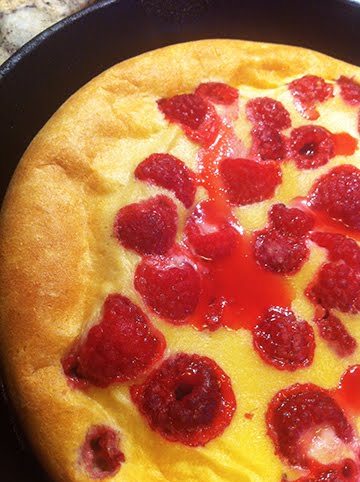 A week has passed since my last blog post (over at the Bread Baker's Dog), which isn't surprising to me. I don't know how all you full-time working people, especially ones with children, too, find the time to blog and take gorgeous photos and everything. I worked every day this week, but not full days on Monday and Friday and I still seemed to not have a spare moment for blogging, nor the energy. My hat is off to y'all who do it all!
A week has passed since my last blog post (over at the Bread Baker's Dog), which isn't surprising to me. I don't know how all you full-time working people, especially ones with children, too, find the time to blog and take gorgeous photos and everything. I worked every day this week, but not full days on Monday and Friday and I still seemed to not have a spare moment for blogging, nor the energy. My hat is off to y'all who do it all!The garden has also been calling. Seeds were pre-sprouted over a week ago and were finally put into soil filled little cells yesterday. Today some had already sprouted above the soil! The sugar snap peas sprouted more quickly, so they were tucked into soil filled paper coffee cups mid-week and will be ready to plant by this Wednesday...if I can find the time.
Yesterday and today were full of shopping for plants weeding, planting seedlings and sowing a few seeds directly into soil outside.
 There is still a whole lot of weeding to do while the ground is still soaked...they come up much easier...and then mulch to put down. Plum trees are blossoming and spring seems to be coming. I know that there is deep snow in many parts of the country and world, but I am a spoiled Calgirl who expects spring flowers in mid-February.
There is still a whole lot of weeding to do while the ground is still soaked...they come up much easier...and then mulch to put down. Plum trees are blossoming and spring seems to be coming. I know that there is deep snow in many parts of the country and world, but I am a spoiled Calgirl who expects spring flowers in mid-February. Also woke early this morning and went west to the beach. There was a very high tide today and big surf so lots of surfers were having fun in the water. Going places with Sweetie is always the best and we both love Doran beach. Xam would have like it better with less surf...too much noise.
Also woke early this morning and went west to the beach. There was a very high tide today and big surf so lots of surfers were having fun in the water. Going places with Sweetie is always the best and we both love Doran beach. Xam would have like it better with less surf...too much noise.Since not much cooking or baking of note has been going on, I'm going to post a dish that I baked over a month ago. Sometimes good things come with time :)
Squash is a vegetable that I love, both summer squash and winter squash. Butternut squash is a favorite because of the deep orange color, mellow taste, and because once you prepare the whole squash, you have a lot of ready to cook with deliciousness at hand.
You can read about the other things I made with the squash here. That is also the post where I give tips for roasting halves of butternut squash.
This calzone was inspired by a pizza I had at a restaurant in January. It combines squash, pancetta, cheese and sage. I also added sauteed leeks that I cooked down with a splash of white wine. With pizza dough both over and under it seemed like a good idea to boost the flavor elements of the filling. I didn't have any pancetta and do believe that it would have been even better with the intense and savory flavor pancetta provides. I used some crisp cooked bacon instead and it was delicious but mellower. You can also eliminate the bacon/pancetta for a vegetarian version.
If you don't have a pizza stone bake this n a parchment lined baking sheet or jelly roll pan turned upside down and placed in the lower part of your oven. Just watch either way to make sure the bottom crust doesn't burn.
BASIC PIZZA DOUGH ~ To Use for Calzone
Original recipe for the dough taken from “The Bread Baker’s Apprentice” by Peter Reinhart.
Makes 12 calzone or 6 pizza (9-12 inch) crusts
Ingredients:
4 1/2 Cups (20 1/4 ounces/607.5 g) Unbleached high-gluten (%14) bread flour or all purpose flour, chilled
1 3/4 Tsp Salt
1 Tsp Instant yeast
1/4 Cup (2 ounces/60g) Olive oil or vegetable oil (both optional, but it’s better with)
1 3/4 Cups (14 ounces/420g or 420ml) Water, ice cold (40° F/4.5° C)
1 Tb sugar
Semolina/durum flour or cornmeal for dusting
DAY ONE
Method:
1. Mix together the flour, salt and instant yeast in a big bowl (or in the bowl of your stand mixer).
2. Add the oil, sugar and cold water and mix well (with the help of a large wooden spoon or with the paddle attachment, on low speed) in order to form a sticky ball of dough. On a clean surface, knead for about 5-7 minutes, until the dough is smooth and the ingredients are homogeneously distributed. If it is too wet, add a little flour (not too much, though) and if it is too dry add 1 or 2 teaspoons extra water.
NOTE: If you are using an electric mixer, switch to the dough hook and mix on medium speed for the same amount of time. The dough should clear the sides of the bowl but stick to the bottom of the bowl. If the dough is too wet, sprinkle in a little more flour, so that it clears the sides. If, on the contrary, it clears the bottom of the bowl, dribble in a teaspoon or two of cold water.
The finished dough should be springy, elastic, and sticky, not just tacky, and register 50°-55° F/10°-13° C.
3. Flour a work surface or counter. Line a jelly pan with baking paper/parchment. Lightly oil the paper.
4. With the help of a metal or plastic dough scraper, cut the dough into 12 equal pieces for calzone(or 6 pieces if you want to make pizzas).
NOTE: To avoid the dough from sticking to the scraper, dip the scraper into water between cuts.
5. Sprinkle some flour over the dough. Make sure your hands are dry and then flour them. Gently round each piece into a ball.
NOTE: If the dough sticks to your hands, then dip your hands into the flour again.
6. Transfer the dough balls to the lined jelly pan and mist them generously with spray oil. Slip the pan into plastic bag or enclose in plastic food wrap.
7. Put the pan into the refrigerator and let the dough rest overnight or for up to thee days.
NOTE: You can store the dough balls in a zippered freezer bag if you want to save some of the dough for any future baking. In that case, pour some oil (a few tablespoons only) in a medium bowl and dip each dough ball into the oil, so that it is completely covered in oil. Then put each ball into a separate bag. Store the bags in the freezer for no longer than 3 months. The day before you plan to make calzone, remember to transfer the dough balls from the freezer to the refrigerator.
DAY TWO
8. On the day you plan to eat calzone, exactly 2 hours before you make it, remove the desired number of dough balls from the refrigerator. Dust the counter with flour and spray lightly with oil. Place the dough balls on a floured surface and sprinkle them with flour. Dust your hands with flour and delicately press the dough into disks about 1/2 inch/1.3 cm thick and 5 inches/12.7 cm in diameter. Sprinkle with flour and mist with oil. Loosely cover the dough rounds with plastic wrap and then allow to rest for 2 hours.
9. At least 45 minutes before making the pizza, place a baking stone on the lower third of the oven. Preheat the oven as hot as possible (500° F/260° C).
NOTE: If you do not have a baking stone, then use the back of a jelly pan. Do not preheat the pan.
Note: In case you would be having trouble rolling the dough or if the dough never wants to expand and always springs back, let it rest for approximately 5-20 minutes in order for the gluten to relax fully,then try again.
On a lightly floured surface roll each dough ball into a circle about 8 or 9 inches in diameter. Place on a sheet of baking parchment paper. Fill as desired. For the Butternut Squash with Sage and Leeks Calzone, fill as described below.
Butternut Squash Calzone with Sage and Leeks
Makes 6
Makes 6
1/2 recipe of the pizza dough described above
12 thin slices cooked and peeled butternut squash, about 3 1/2 to 4 inches by 1 1/2 to 2 inches
1 cup ricotta cheese - if very moist, drain for 1/2 hour in cheese cloth over a sieve
1 tablespoon fresh sage, finely chopped
1/2 tablespoon fresh Italian parsley, finely chopped
1 egg,lightly beaten, divided
2 tablespoons freshly grated Parmesan cheese
1 large or two small leeks, washed well, quartered, and sliced in thin slices
2 teaspoons olive oil
1 tablespoon white wine
1/4 lb bacon or pancetta
1 cup grated mozzarella cheese
salt and pepper to taste
additional Parmesan if desired
In a small bowl, mix the ricotta cheese, fresh sage, Italian parsley, half of the egg (reserve the other half to glaze the tops of the calzone), and Parmesan cheese. Set aside.
In a medium skillet, over low heat cook the leeks in the olive oil until translucent, about 15 minutes. Add the white wine, adjust heat to high, and, stirring constantly, cook the leeks until almost all of the liquid has evaporated. Set aside.
Wipe out the skillet and cook the bacon until crisp. If using pancetta, cook until crisp, but watch carefully to not burn it. Once crisp, remove to paper towels and let the towels absorb any fat.
1 cup ricotta cheese - if very moist, drain for 1/2 hour in cheese cloth over a sieve
1 tablespoon fresh sage, finely chopped
1/2 tablespoon fresh Italian parsley, finely chopped
1 egg,lightly beaten, divided
2 tablespoons freshly grated Parmesan cheese
1 large or two small leeks, washed well, quartered, and sliced in thin slices
2 teaspoons olive oil
1 tablespoon white wine
1/4 lb bacon or pancetta
1 cup grated mozzarella cheese
salt and pepper to taste
additional Parmesan if desired
In a small bowl, mix the ricotta cheese, fresh sage, Italian parsley, half of the egg (reserve the other half to glaze the tops of the calzone), and Parmesan cheese. Set aside.
In a medium skillet, over low heat cook the leeks in the olive oil until translucent, about 15 minutes. Add the white wine, adjust heat to high, and, stirring constantly, cook the leeks until almost all of the liquid has evaporated. Set aside.
Wipe out the skillet and cook the bacon until crisp. If using pancetta, cook until crisp, but watch carefully to not burn it. Once crisp, remove to paper towels and let the towels absorb any fat.

To assemble the calzone, roll out as described above and place on pieces of baking parchment. Spread about 1 - 2 tablespoons of the ricotta mixture over half of the dough circle. Top with a sixth of the leeks, distributing the leeks over the ricotta. Do the same with the bacon or pancetta, breaking the crisp pieces into small pieces as necessary.
 Top with one or two of the butternut squash pieces, having the curved side toward the outside of the circle and the flat side toward the middle of the circle of dough. Sprinkle on one sixth of the mozzarella cheese and salt and pepper to taste.
Top with one or two of the butternut squash pieces, having the curved side toward the outside of the circle and the flat side toward the middle of the circle of dough. Sprinkle on one sixth of the mozzarella cheese and salt and pepper to taste.
 Top with one or two of the butternut squash pieces, having the curved side toward the outside of the circle and the flat side toward the middle of the circle of dough. Sprinkle on one sixth of the mozzarella cheese and salt and pepper to taste.
Top with one or two of the butternut squash pieces, having the curved side toward the outside of the circle and the flat side toward the middle of the circle of dough. Sprinkle on one sixth of the mozzarella cheese and salt and pepper to taste.Fold the plain half of the dough over the filled half. Run a finger that you have dipped in water around the edge of the filled section and press the top dough to seal. Use the tines of a fork to press all around the edge to seal further. If desired, glaze the dough with some of the beaten egg and sprinkle with additional Parmesan cheese. Set aside and make the other five calzone. If there are dough balls left, save for pizza or more calzone. They can be frozen to be used later, too.
Once all the calzone have been filled, check to make sure that the pre-heated oven is hot.
If you are using a baking stone, slide the calzone, still on its parchment onto the stone and bake until the dough is golden brown. Repeat with each of the other calzone.
Let cool a couple of minutes, then remove from the paper to a cutting board and cut each into four pieces. Serve at once.
If you are using a baking stone, slide the calzone, still on its parchment onto the stone and bake until the dough is golden brown. Repeat with each of the other calzone.
Let cool a couple of minutes, then remove from the paper to a cutting board and cut each into four pieces. Serve at once.
































